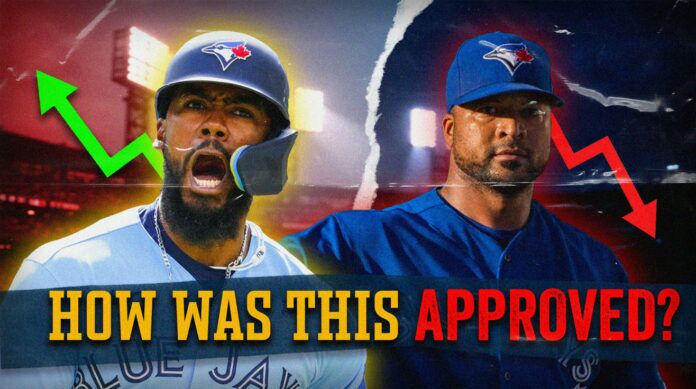
Every July, the MLB trade deadline impact ripples through franchises, forcing front offices to weigh short-term glory against long-term stability. Your favorite team’s biggest mistake probably happened during one of these frantic deadline days, when normally cautious general managers turn into high-stakes gamblers pushing all their chips forward with unwavering certainty.
The deadline creates baseball’s most fascinating risk-reward scenarios where contenders mortgage pieces of tomorrow for tantalizing October glory today. Sellers perform delicate calculus, determining when a beloved veteran’s value has peaked, often dismaying fanbases that form emotional attachments spreadsheets cannot quantify.
5. The Astros-Blue Jays Exchange: How Houston Missed Their Teoscar
Houston’s 2017 championship push led them to target Toronto’s Francisco Liriano, sending outfielder Nori Aoki and prospect Teoscar Hernandez north of the border. The Teoscar Hernández Trades and Transactions record shows how a seemingly minor deadline deal can dramatically alter the trajectory of multiple franchises.
Liriano contributed just 0.1 WAR working primarily from Houston’s bullpen while the Astros secured their World Series trophy. Hernandez transformed in Toronto, eventually hammering 129 home runs with a robust 126 OPS+ and accumulating 14.2 WAR across six seasons. Watching Hernandez blossom elsewhere surely stings like realizing you sold a winning stock right before it skyrocketed, though that championship ring probably eases the pain.
4. The Cardinals’ Pitching Panic: Lester for Thomas
Injuries decimated St. Louis’s rotation in 2021, leaving Jack Flaherty and Miles Mikolas on the shelf as the Cardinals reached for the security blanket named Jon Lester. The Nationals trade Jon Lester to Cardinals for Lane Thomas deal was initially seen as a minor move, but hindsight reveals its far-reaching impact on both organizations.
Thomas went from spare part to cornerstone after arriving in Washington, launching 53 home runs since the trade and joining the exclusive 20/20 club in 2023 while providing approximately 6 WAR of value. Lester consumed innings with veteran efficiency but little else, posting a 4.36 ERA across 12 starts before retirement. The Cardinals essentially traded a promising young asset for temporary help that provided minimal impact.
3. Brewers’ Bullpen Blunder: Olson for Norris
The search for bullpen help often drives deadline decisions, like when Milwaukee shipped pitching prospect Reese Olson to Detroit for reliever Daniel Norris in 2021. Few baseball observers batted an eye as the Brewers addressed an immediate bullpen need while Detroit added another young arm to their rebuilding project. As highlighted in the Detroit Tigers Prospect Audit: Reese Olson, Olson’s development into a rotation mainstay underscores the hidden risks of deadline bullpen rentals.
Fast forward to today, and Olson has emerged as a legitimate rotation cornerstone with a 3.58 career ERA for Detroit, showcasing the ceiling that made him a prospect worth coveting. This seemingly minor transaction has already created significant advantage for Detroit, with Olson’s continued development suggesting the gap may widen dramatically in coming years. The Brewers’ decision resembles giving away a valuable asset without fully understanding its potential worth.
2. The Angels’ Foundation Problem: Greinke for Segura
The 2012 deadline featured something like a blockbuster deal where the Angels acquired Zack Greinke from the Brewers while Milwaukee received shortstop Jean Segura in return, exemplifying the dangers of win-now moves without proper organizational foundation. This trade looked brilliant on paper – the Angels desperately needed ace-level pitching for their playoff push.
Segura flourished in Milwaukee, stealing 44 bases in 2013 alone and becoming the dynamic infielder the Angels desperately needed at multiple positions. Greinke posted a respectable 3.53 ERA with the Angels and generated 1.5 WAR during his brief tenure, but couldn’t prevent their playoff miss despite his solid contributions.
The team’s aggressive move was akin to someone installing marble countertops while the foundation crumbles beneath them, a cautionary tale about addressing symptoms rather than underlying structural weaknesses.
1. When Prospects Become Problems
Baseball’s cruelest irony lies in how trades that seem prudent in July often look catastrophic by October of the following year. Front offices operate under enormous pressure during deadline week, making franchise-altering decisions with incomplete information and sleep-deprived judgment that would test even the most experienced decision-makers.
The beauty of these butterfly effect trades isn’t just their unpredictability – it’s how they remind everyone that talent evaluation remains more art than science, even in our analytics-obsessed era. Teams continue chasing immediate gratification while prospects develop in unexpected ways, creating the perpetual cycle of deadline regret that makes baseball’s trade season endlessly compelling for fans who love second-guessing their favorite executives.


